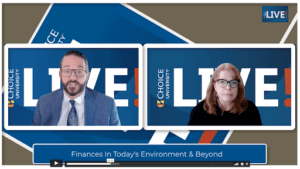Bandwidth is a perennial challenge for leaders in the learning and development space. When times are tough and budgets are tight, L&D teams are usually the first to go and the last to grow. Companies faced clear shifts in 2020 due to the COVID-19 outbreak, with business strategies and organizational priorities literally changing overnight. L&D teams had to quickly adapt, redeploying their efforts and resources from previously established priorities to new ones demanding immediate attention.
Like many L&D teams, Choice University experienced a pronounced and prolonged increase in learning requests throughout the pandemic. Responsible for providing learning to 7000-plus independently owned and operated Choice Hotels franchise properties worldwide, ChoiceU came alongside hotels with learning resources to help navigate the roller coaster of the pandemic. And while the business needs and requests for learning content grew rapidly and exponentially in 2020, those needs have increased even more in 2021.
For example, ChoiceU has noted a 65 percent increase in learning requests year over year. Even with 100 percent retention of ChoiceU staff in the comparative time frame, we feel the pressure to “do more with less” due to the sharp increase in needs. It is more important than ever for our L&D team to work smarter and set expectations with our organizational business partners, and right-size the deliverables we produce to meet the business’s growing needs.
To accomplish this, ChoiceU employed five distinct strategies that helped meet ever-growing business needs with tight resources through the pandemic and into recovery. The strategies include prioritization, MVP, fast-track development, self-service development and assignment by interest. Though put into practice during the pandemic, we are bringing them into the future of our L&D strategy, even as our bandwidth expands once again.
Prioritization
The first strategy, prioritization, starts with having a clear vision of what is most important to the company in achieving its goals. For ChoiceU, this means supporting hotels with learning resources to help drive business performance and we base every decision about the projects we undertake on what will most impact hotel performance.
The pandemic prompted a dramatic increase in our hotel workforces’ learning needs. However, with fewer staff, hotel leaders had limited time to dedicate to the learning they craved. Our team needed to excel at prioritizing not only for our own bandwidth but also for the hotels.
To do this, ChoiceU leadership meets weekly to review the current priorities and surface new requests. The leadership group is empowered to make on-the-spot decisions regarding new requests and whether current projects are deprioritized. Of course, one of the hurdles with re-prioritization is how we manage expectations with our internal stakeholders across the organization. Each stakeholder’s learning request is the highest priority to them, so it is important our L&D leaders take a strategic view of all needs across the organization for sound judgment on where L&D can have the greatest impact. While it is still a difficult conversation to tell a stakeholder their request falls behind others, it is usually better-received when we can provide a solid, strategic rationale for the decision.
During the height of the pandemic, priorities were frequently adjusted and work shuffled as needed. Now in recovery, there are fewer re-prioritizations, but the weekly leadership review of projects is still critical to ensure our priorities are continually aligned with the organization’s needs and business goals.
MVP
We borrowed the second strategy, scoping deliverables to MVP — minimally viable product — from product engineering. We plan to deliver the precise learning experience and content needed in the moment. Learning developers love developing, so scoping projects to MVP prevents the age-old challenge of always wanting to build a beautiful “Cadillac” with all the bells and whistles when what is actually needed is a reliable moped. By focusing on building just what learners need right now while phasing more over time as needed, our team can address learners’ needs more quickly and our learners will be less overwhelmed by a high volume of content.
Not all projects can be scoped to MVP, however. That same clear vision and strategic view that helps with prioritization similarly guides the ChoiceU leadership team on when we need to deliver a fast MVP solution and when we should build a more extravagant learning solution.
It may be difficult to convince your L&D team members, who often want to flex their development skills and try out the latest tools on projects, but they can still develop their skills on an MVP-sized deliverable. And stakeholders may feel they are not getting enough with an MVP solution. There isn’t a one-size-fits all solution for this, but we have found that simply listening and aligning with stakeholders (and your team!) on what they hope to achieve with the learning and the end-goal for the business can be a simple yet influential approach.
Fast-track development
It is uncommon that the L&D team is a subject matter expert on every learning topic. For ChoiceU, we pair our expertise of L&D methods with that of subject matter experts from across the organization to develop high-impact learning assets. To do this well takes time: gaining a great enough understanding about the learning topic from our organizational partners to develop effective training.
As information was ever evolving during the pandemic, ChoiceU identified a fast-track methodology to transfer knowledge from subject matter experts to our hotel learners, sometimes in as little as a few days. CU Live is an interview-style method we have used in-person at our annual convention and occasionally for live interviews produced in the office, yet we had barely scratched the surface of possibilities.

Using video conferencing technology to capture the side-by-side interview look, the video interviews align with the CU Live brand with which our learners were already familiar. The result is a fast-track development of videos that provide direct access to the information learners need in less time. In place of the standard development cycle to translate a subject matter expert’s knowledge into an animated video, e-lesson, etc., we have the expert teach directly on the topic. Minimal content preparation for a CU Live video includes coaching the expert to create effective talking points and drafting complementary questions. These simple preparations and the use of a branded CU Live virtual background makes for a highly polished look and hastens the editing process. As a geographically dispersed organization, this approach will continue to be one we use well after the pandemic.
Self-service development
There are a handful of subject matter experts we partner with most frequently on developing learning resources; they have become very familiar with our approach and philosophy on learning delivery. To keep momentum on their learning requests, ChoiceU created a self-service partnership model. The model gives our business partner latitude to prepare pieces of the learning content on their own, and an assigned L&D team member offers support at predetermined points of the development process.

At the onset, we align on the specific topic and approach. We then provide feedback on storyboards, scripts, or other elements of the learning before the content is recorded. Lastly, ChoiceU handles the final phase of development: editing. While these self-service projects still require L&D bandwidth and are prioritized alongside other learning needs, they are often able to be worked on between other larger projects. Our business partners improve and grow over time, so this self-service model requires less bandwidth from the L&D team with each instance.
This self-service development doesn’t work for every business partner. We typically offer this model only to those stakeholders who have partnered with us previously, understand our learners’ preferences and are strongly aligned with our learning philosophy. But when mutual respect and trust are present, this model is great for stakeholders who are creative, driven and thrive on autonomy.
Assignment by interest
The last strategy is quite simple. Our L&D team tells us what they want to work on, and we do our best to accommodate. It is amazing how we can almost always find ways to manage work to create margin for the things that interest us most. The goal is not to overburden the team or to encourage working so fast that quality suffers, but to democratize the assignment of work where possible to engage people’s interests. When people are passionate about their work, the process and the product are always better.
Looking forward
As the country moves through recovery, in its various phases, L&D leaders should be assessing what their teams have learned from the changes they implemented during crisis mode, and deciding which new approaches to continue in the long-term for the future of L&D work. On their own, any one of these strategies will make a difference for increasingly overburdened L&D teams with tight bandwidth.















